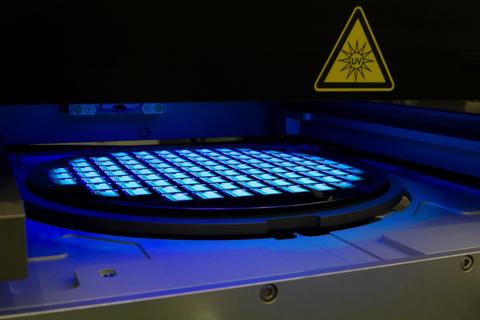Summary
The objective for Advanced IC Interconnects is to provide measurement standards and advanced measurement methods supporting metrology needs of the semiconductor industry. Also to develop in situ metrologies sensitive to atomic layer deposition chemistry and atomic layer deposition chemical reaction mechanisms supporting development of atomic layer deposition process models.
Description

Atomic layer deposition (ALD) is increasingly being utilized as a method of depositing the thin (nanometer-scale), conformal layers required for many microelectronics applications, including high - gate dielectric layers, diffusion barrier layers, copper seed layers, and DRAM dielectric layers. However, significant developmental issues remain for many of these applications. A potential solution to some ALD developmental issues is technology computer-aided design (TCAD). TCAD has been identified in the 2003 International Technology Roadmap for Semiconductors (ITRS) as "one of the few enabling methodologies that can reduce development cycle times and costs."[2003 ITRS, Modeling and Simulation, page 1] However, many difficult challenges to development of validated, predictive ALD process models that allow prediction of equipment influences on film properties have been identified, including "Fundamental physical data (e.g., rate constants, cross sections, surface chemistry); reaction mechanisms, and reduced models for complex chemistry".[2003 ITRS, Modeling and Simulation, Table 121, page 2] In addition to a lack of quality fundamental physical and chemical data, experimental validation has been identified as a "key difficult challenge across all modeling areas."[2003 ITRS, Modeling and Simulation, page 1] Further, with respect to experimental validation, "The major effort required for better model validation is without doubt sensor development."[2003 ITRS, Modeling and Simulation, page 15] This project is an attempt to assist in solving some ALD developmental issues by developing validated, predictive process models and associated in situ metrologies for ALD processes.
Research efforts in this project involve two primary directions: development of in situ metrologies sensitive to ALD chemistry and development of ALD chemical reaction mechanisms. These two directions are mutually-supporting. It is expected that experimental results that elucidate ALD chemistry will aid in chemical mechanism development and ultimately in process model validation. Further, it is expected that the most important reaction species will be identified as understanding of a particular ALD reaction improves, thus facilitating the design of improved process metrologies. Ultimately, aspects of both of metrology development and reaction mechanism development will be required to create validated ALD process models. Incorporating the chemical reaction mechanisms developed at NIST into commercially available computational fluid dynamics code, and then validating the process model under a range of parameters using experimental data collected in the course of this project would create ALD process models useful for the design and operation of commercial ALD tools. Initially, Hafnium oxide films will be deposited from tetrakis(dimethylamino) hafnium and water. Chemical models of HfO 2 and Al 2 O 3 ALD process chemistry are being developed and will be incorporated into the two-dimensional numerical reactor model.
Major Accomplishments
- ALD Reactor Construction — Research-grade, optically-accessible ALD reactors have been designed and constructed with full optical access for surface and gas-phase Raman and FTIR spectroscopic measurements.
- HfO 2 ALD — Using apulsed gas delivery system, ALD HfO 2 films were deposited under a variety of process parameters using tetrakis(dimethylamino) hafnium, Hf[N(CH 3 ) 2 ] 4 , and water. Films have been characterized with a number of techniques, including VUV-SE.
- In Situ Optical Measurements — In situ surface Raman spectroscopic measurements are on going. Excitation wavelengths are being varied to evaluate maximum sensitivity to ALD species. The in situ gas phase and surface FTIR systems have been assembled and preliminary measurements have begun.
- Chemical Properties Calculations — Molecular structures and energies for precursors, adsorbates, intermediates, and transition states have been calculated using ab initio and density functional theory quantum calculations for ALD of Al 2 O 3 from trimethyl aluminum and water.
- ALD Reactor Modeling — A two dimensional CFD model has been developed based on the dimensions of the experimental ALD reactor(s). Numerical solutions have been obtained for flow and a heated substrate with and without full chemistry for ALD of Al 2 O 3 from TMA and water
Future Plans
- Assembly of an infrared spectroscopic system for in situ measurements during ALD processes
- Measurement of the in situ vibrational spectra of surface species present during ALD processes
- Interface mass spectrometer to ALD chamber and correlate mass spectrometric results with optical spectroscopic results
- Interface quartz crystal microbalance monitor to ALD chamber and correlate these results with chemical measurements
Associated Publications
1. Hiebert, M. E., Weaver, J., Lam, T., Little, N., Hyde, E., Vicenzi, E. P., and Phaneuf, R. J., "ALD deposited amorphous alumina coatings can slow glass alteration," Physics and Chemistry of Glasses-European Journal of Glass Science and Technology Part B, 63, 97-110 (2022).
2. Mertens, L. A. and Manion, J. A., "Kinetics of isopropanol decomposition and reaction with H atoms from shock tube experiments and rate constant optimization using the method of uncertainty minimization using polynomial chaos expansions (MUM-PCE)," International Journal of Chemical Kinetics, 53, 95-126 (2021).
3. Sperling, B. A., Kalanyan, B., and Maslar, J. E., "Atomic Layer Deposition of Al2O3 Using Trimethylaluminum and H2O: The Kinetics of the H2O Half-Cycle," Journal of Physical Chemistry C, 124, 3410-3420 (2020).
4. Kalanyan, B., Beams, R., Katz, M. B., Davydov, A. V., Maslar, J. E., and Kanjolia, R. K., "MoS2 thin films from a ((NBu)-Bu-t)(2)(NMe2)(2)Mo and 1-propanethiol atomic layer deposition process," Journal of Vacuum Science & Technology A, 37, (2019).

